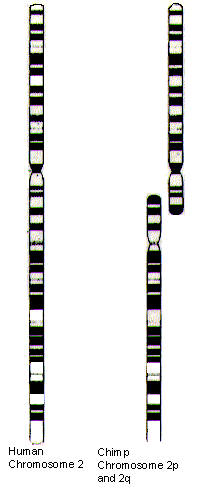SStar, asked our final question of my request line (the request line is still open, so fee free to ask something) and it’s a good one. It took me a bit of research, which is why I did it last. However, I’ve got the answer. Here’s the question:
Okay I have one, regarding chromosome 2. At a particular point in time there must have been one and one only single ancestor that was born with the fused chromosome. He/she was the only one of his species with this particular mutation. Now we know that species with different chromosome count can’t interbreed. So how is it possible for this mutation to have be passed and how is it possible for the mutation to have become totally dominant through natural selection as it seems to be neutral.
First, a bit of background. The Homo sapiens chromosome 2 is one of the single best pieces of evidence to support common descent. Modern H. sapiens have 46 chromosomes in 23 pairs. However, the other critters from our lineage have 48 chromosomes in 24 pairs. This could present a problem, but instead, it offers the best evidence that humans and apes really do have a common ancestor.
Scientists, once they started looking at chromosomes, knew this was an issue. What they found though was that the human chromosome 2 matched, exactly, with TWO ape chromosomes (called 2p and 2q usually). Then they discovered the second centromere. The centromere is a special section of the DNA in a chromatid that allows it to link up with it’s opposite number and form the chromosome that you see in karyotypes. Here’s a picture to explain.
In this image, number 1 is a cromatid. Two of them make up a chromosome. Number 2, is where the two cromatids link up, the centromere. Three and four are the short arm and the long arm respectively.
Now here’s an image comparing the ape versions and the human version.

The pinched area is where the centromere is. If you look closely, the banding patter in the two sets of chromosomes are the same. Further, if you look just below the centromere in the human chromosome 2, you will see a greyish area that matches the centromere in the 2q chromosome of apes. That’s the evidence that the two ape chromosomes have combined into one human chromosome. No chromosome needs two centromeres, but if one became non-functional after a merging event… well… that just matches what evolutionary theory predicts.
Now, here’s where sstar’s question comes into play.
The first organism that had this mutation would have a different number of chromosomes than everyone else in the population and that presents a problem. For example, we all know that horses and donkeys breed and form sterile mules. Part of the reason that mules are sterile is that horses have 64 chromosomes and donkeys have 62. Wouldn’t this same issue occur with the first organism that had the combination mutation?
The answer is… not really.
The reason is that, unlike the horse/donkey hybrid, that first individual who had the fused chromosome 2p and 2q still has all of the genetic material of the rest of the population. Horses and donkeys do not have the same genetic material, they are closely related, but not in the same species. The process is called a balanced Robertsonian translocation.
Now, when meiosis occurs, the chromosomes are mixed and separated. One half of each chromosome comes from each parent. So, the parent with the fused chromosome can provide a couple of different versions of the chromosome(s).
A normal individual would have a pair of 2p and a pair of 2q chromosomes.
The affected individual has a single 2p, a single 2q, and a fused 2pq. Follow me so far?
Now, when meiosis occurs in a normal individual, the gamete will have a single 2p and a single 2q.
In our affected individual, the gamete could have
- a single 2p and a single 2q – resulting in perfectly normal offspring
- a single 2pq – resulting in perfectly normal offspring. All the genetic material is present, just in an odd shape and the other parent’s 2p and 2q chromosomes will link up nicely.
- a 2p and the 2pq – this is bad. This is basically what happens in some versions of Down’s syndrome cases.
- a 2q and the 2pq – this is also bad, the same as number 3.
So, in the case of that first individual with the fused 2pq chromosome, it had (probably several) offspring where the gamete formed was of the #2 variety. Just the fused chromosome and that’s all. This would result in perfectly normal offspring.

